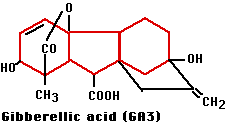
During the 1930s Japanese scientists isolated a growth-promoting substance from cultures of a fungus that parasitizes rice plants. They called it gibberellin.
After the delay caused by World War II, plant physiologists in other countries succeeded in isolating more than 30 closely-related compounds. One of the most active of these — and one found as a natural hormone in the plants themselves — is gibberellic acid (GA).
GA has a number of effects on plant growth, but the most dramatic is its effect on stem growth. When applied in low concentrations to a bush or "dwarf" bean, the stem begins to grow rapidly. The length of the internodes becomes so great that the plant becomes indistinguishable from climbing or "pole" beans. GA seems to overcome the genetic limitations in many dwarf varieties.
Synthesis of gibberellins also helps grapevines climb up toward the light by causing meristems that would have developed into flowers to develop into tendrils instead.
| One of the 7 pairs of traits that Mendel studied in peas as he worked out the basic rules of inheritance was dwarf-tall. The recessive gene - today called le - turns out to encode an enzyme that is defective in enabling the plant to synthesize GA. The dominant gene, Le, encodes a functioning enzyme permitting normal GA synthesis and making the "tall" phenotype. |
Gibberellins exert their effects by altering gene transcription.
The steps:This mechanism is another of the many cases in biology where a pathway is turned on by inhibiting the inhibitor of that pathway (a double-negative is a positive).
Another example: Auxin.Although most of the specific proteins involved are quite different, both gibberellins and auxin affect gene expression by a similar mechanism of relief of repression.
| Ligand | Gibberellins | Auxin |
| Receptor | GID1 | TIR1 |
| Proteasome activator | SCF | SCF |
| Transcription factor repressor | DELLA | Aux/IAA |
| Transcription factor | PIF3/4 | ARF1 |
The dwarf varieties of rice and wheat that have played such an important part in the "green revolution" carry mutant genes that
Dwarf varieties of sorghum and — more recently — maize (corn) also exist, but in these cases, the mutation interferes with auxin transport, not gibberellin activity.
| Other plant hormones | ||||||
|---|---|---|---|---|---|---|
| Abscisic acid (ABA) | Auxin | Brassinosteroids | Cytokinins | Ethylene | Jasmonates | Strigolactones |
| As you read about these various hormones, you will note that: (1) each hormone affects several, or even many, different processes and (2) each process is, in turn, influenced by several different hormones. How these overlapping signals are integrated to produce a particular response remains a topic of active research. | ||||||
| Welcome&Next Search |